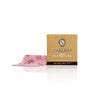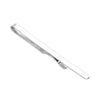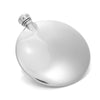- What Are Cufflinks & Why They Matter
- The Gentleman’s Code: When to Wear Them
- How to Wear Cufflinks (With or Without French Cuffs)
- Cufflink Types Explained (Chain, Toggle, Silk Knot)
- Materials & Craftsmanship (Sterling Silver, 9ct Gold, Enamel, Mother of Pearl)
- Engraving and Personalisation Tips
- Maintenance & Storage
- Best Occasions: Weddings, Black Tie, Corporate Events
- How to Wear Cufflinks with Any Shirt (separate post)
- When to wear Gold vs. Silver cufflinks (separate post)
Cufflinks & Why They Matter
Cufflinks are more than fastenings; they’re a quiet expression of taste. Where a button simply performs a function, a cufflink makes a statement: of occasion, attention to detail, and respect for tradition.
At their simplest, cufflinks secure the two sides of a double (or French) cuff shirt. But in truth, they do far more than hold fabric together. They signal care, the kind that comes from taking time to dress properly, to choose a piece that reflects the day, the event, or the person receiving it.
At Sayers London, we see cufflinks as heirlooms in waiting. Each pair is designed to last a lifetime, crafted from solid sterling silver or 9ct gold, and often chosen to mark life’s most meaningful moments: a wedding morning, a promotion, a retirement, a milestone birthday. Engraving transforms them further, turning an accessory into something uniquely personal.
Whether worn daily in the boardroom or brought out for black-tie evenings, cufflinks remain one of the few accessories that can bridge utility, sentiment, and craftsmanship so elegantly. They are small in scale, but never in significance.
The Gentleman’s Code: When to Wear Them
Cufflinks belong to moments that deserve care and ceremony. They feel at home at weddings, black tie dinners, investitures, and milestone celebrations. They also suit the working day when the dress code is formal, the meeting is decisive, or the client is worth impressing. If you would reach for a proper shoe and a pressed shirt, you are in cufflink territory.
Black tie expects them. A crisp evening shirt with double cuffs, polished shoes, and discreet cufflinks is the classic foundation. Daytime formality invites a similar approach. Board meetings, presentations, interviews, and important lunches all carry well with a French cuff and a restrained pair in sterling silver or 9ct gold.
Silver complements cool palettes and navy suits and works across most offices in London. Yellow gold pairs naturally with warmer cloth and evening settings.
There are quieter occasions where cufflinks are a mark of respect. Funerals and remembrance services call for understatement, not display. Choose simple silver, a plain oval or bar, and let the finish speak softly.
Match metals and mood. Silver complements cool palettes and navy suits and works across most offices in London. Yellow gold pairs naturally with warmer cloth and evening settings. Keep metals consistent where you can. Align cufflinks with your watch case, your belt buckle, and any tie bar to create a coherent line.
Let the shirt guide you. Double cuffs are designed for cufflinks and always look correct. Convertible cuffs can take them when you want a smarter impression. Regular button cuffs are not suitable, so keep those for casual days.
Personalisation can mark the moment without drawing the eye. Initials, a date, or a short inscription on the reverse gives meaning to a wedding morning, a promotion, or a retirement. Keep the message brief and timeless, so the cufflinks remain versatile long after the event.
In short, wear cufflinks when the day matters, when the dress code is formal, and when you want your appearance to carry quiet authority. Choose quality materials, keep the design considered, and let the details do the talking.
How to Wear Cufflinks (With or Without French Cuffs)
Wearing cufflinks correctly is about precision and restraint. They are small pieces of engineering designed to sit neatly against the wrist, aligning the edges of a double cuff so the shirt looks structured and deliberate. A well-fitted cufflink should feel balanced — not loose enough to move freely, and not so tight that it pulls the fabric.
Looking for detailed advice on pairing cufflinks with different shirts? Read our full guide on How to Wear Cufflinks with Any Shirt, which includes practical advice on button cuffs, convertible styles, and adapting modern shirts.

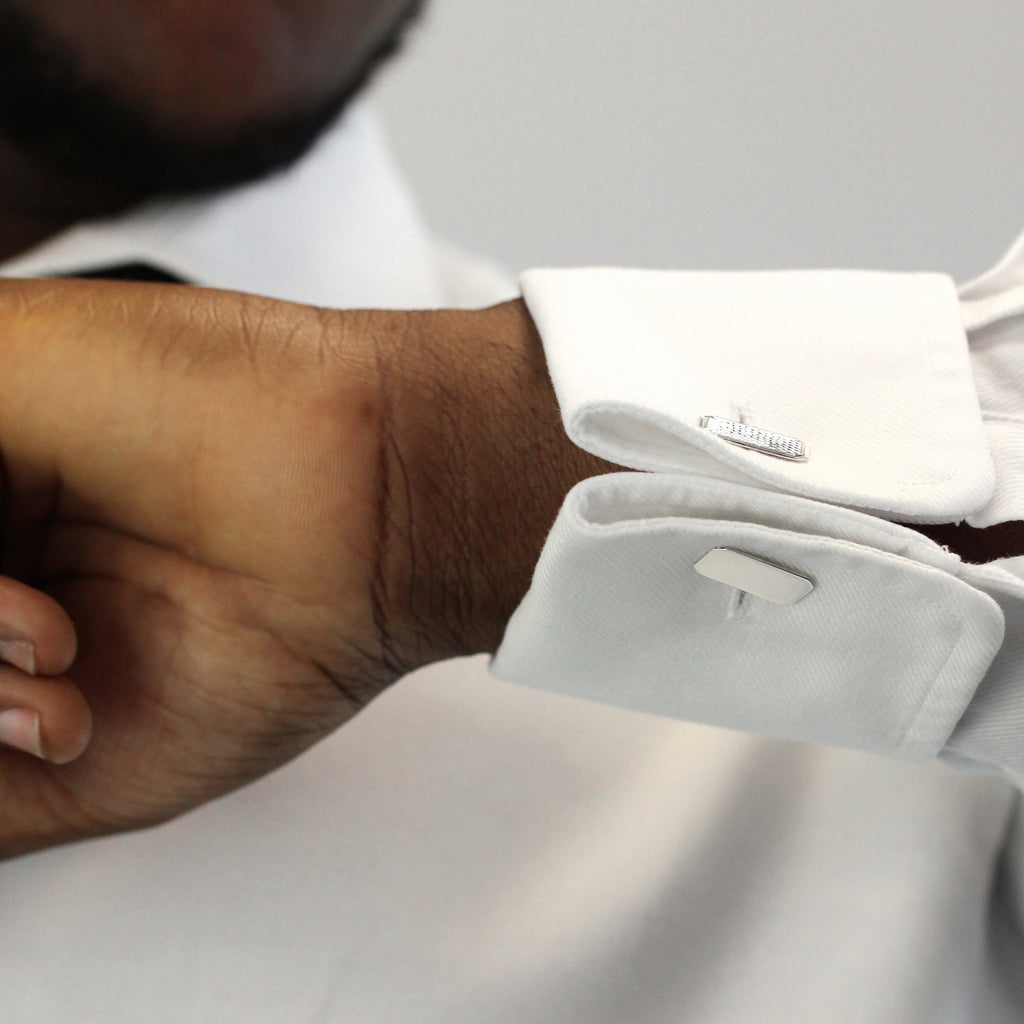
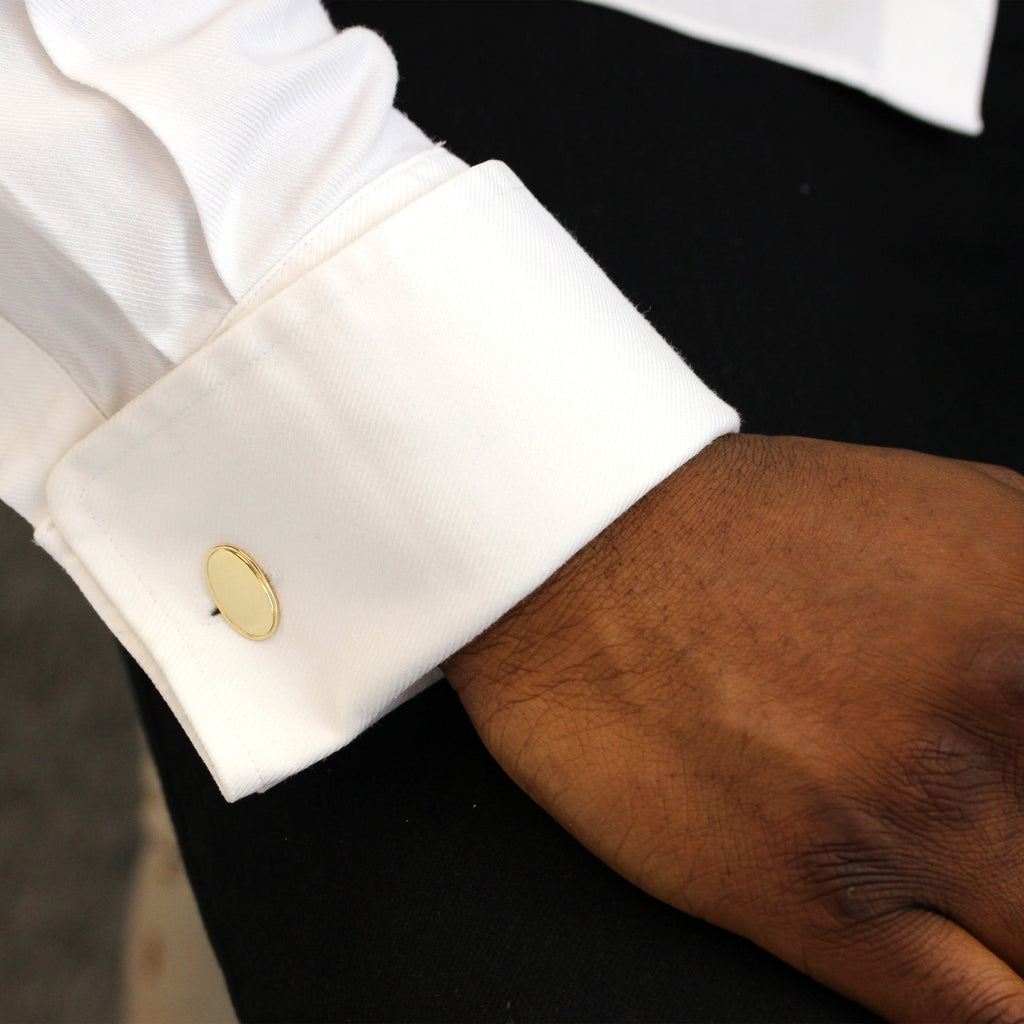
Start with a French cuff, also called a double cuff. Fold the cuff back on itself so the edges meet evenly, then thread the cufflink through the aligned holes from the outside in. The decorative face should sit outward, visible when your arms are by your sides. Secure the toggle or chain so that the link lies flat and parallel to the cuff, never at an angle.
French cuffs are the hallmark of formal dressing — they demand cufflinks by design. A plain white or pale blue shirt with double cuffs instantly elevates a suit, even before you add a tie or pocket square.
If your shirt has convertible cuffs, the process is the same. These are single cuffs with an extra buttonhole, giving you the choice between buttons or cufflinks. They are a practical bridge between formality and ease, ideal for modern offices where the full French cuff might feel too ceremonial.
Standard button cuffs, by contrast, are not made for cufflinks. Forcing one through damages the fabric and never looks right. Save cufflinks for shirts designed to carry them properly — that’s where they make their mark.
When pairing cufflinks with a suit, keep proportion in mind. Larger, heavier cufflinks suit heavier cloths and wider cuffs. Slimmer designs pair better with fine shirting and tailored suits. If your cufflinks feature colour — enamel, onyx, or mother of pearl — echo that tone subtly elsewhere, perhaps in your tie or pocket square. The goal is coherence, not coordination.
Cufflinks should never shout for attention. The most confident statement is made quietly — through finish, proportion, and the assurance of someone who knows when formality still matters.
Whether you prefer the mechanical precision of a toggle back or the simplicity of a fixed oval, wearing cufflinks well is about care. Align the cuff edges cleanly, let the link sit flat, and keep the rest of your accessories in balance. That’s all the ceremony required.
Cufflink Types Explained (Chain, Toggle, Silk Knot)
While their purpose is consistent, cufflinks come in several distinct forms, each with its own mechanism, feel, and level of formality. Understanding the difference is part of knowing when to wear which, and how to build a collection that suits every occasion.
Chain Link Cufflinks are the traditional choice. They feature two decorative faces connected by a short chain, allowing a little movement at the cuff. This flexibility makes them comfortable to wear and lends a slightly relaxed elegance that works well for formal events with a touch of character. They take a moment longer to fasten, but that ceremony is part of their charm.
The chain link is the original cufflink design — discreetly mechanical and quietly graceful, it’s still preferred by those who appreciate understatement.
Toggle or Swivel Back Cufflinks are the most common today. They use a small hinged bar that flips into place once through the cuff, securing the link firmly. This style combines practicality with polish, perfect for everyday business wear or as a thoughtful gift that balances ease and tradition. Many of Sayers London’s sterling silver and 9ct gold cufflinks use this fitting for precisely that reason — it’s reliable, precise, and timeless.
Silk Knot Cufflinks are made from twisted cords of coloured silk or elastic, forming two knots joined by a short length of cord. They are lightweight, informal, and often chosen for travel or to add a discreet hint of colour. While they lack the permanence of metal, they are inexpensive and can complement patterned shirts or summer suits effortlessly. 'Silk knot' cufflinks can also be made from sterling silver
Choose your cufflink type the way you would choose a watch strap — it changes the character of the same outfit without altering the essentials.
Each design has its place. Chain links favour evening formality, toggles serve the office and everyday wear, and silk knots bring ease and versatility. A well-rounded collection includes all three, ready for any occasion where the cuffs deserve attention.
Materials & Craftsmanship (Sterling Silver, 9ct Gold, Enamel, Mother of Pearl)
The choice of material defines both the look and the legacy of a pair of cufflinks. It influences not only their colour and weight, but their feel in the hand and how they age over time. At Sayers London, each material is chosen with purpose — selected for beauty, durability, and the quiet authority that fine metals bring to formal dress.
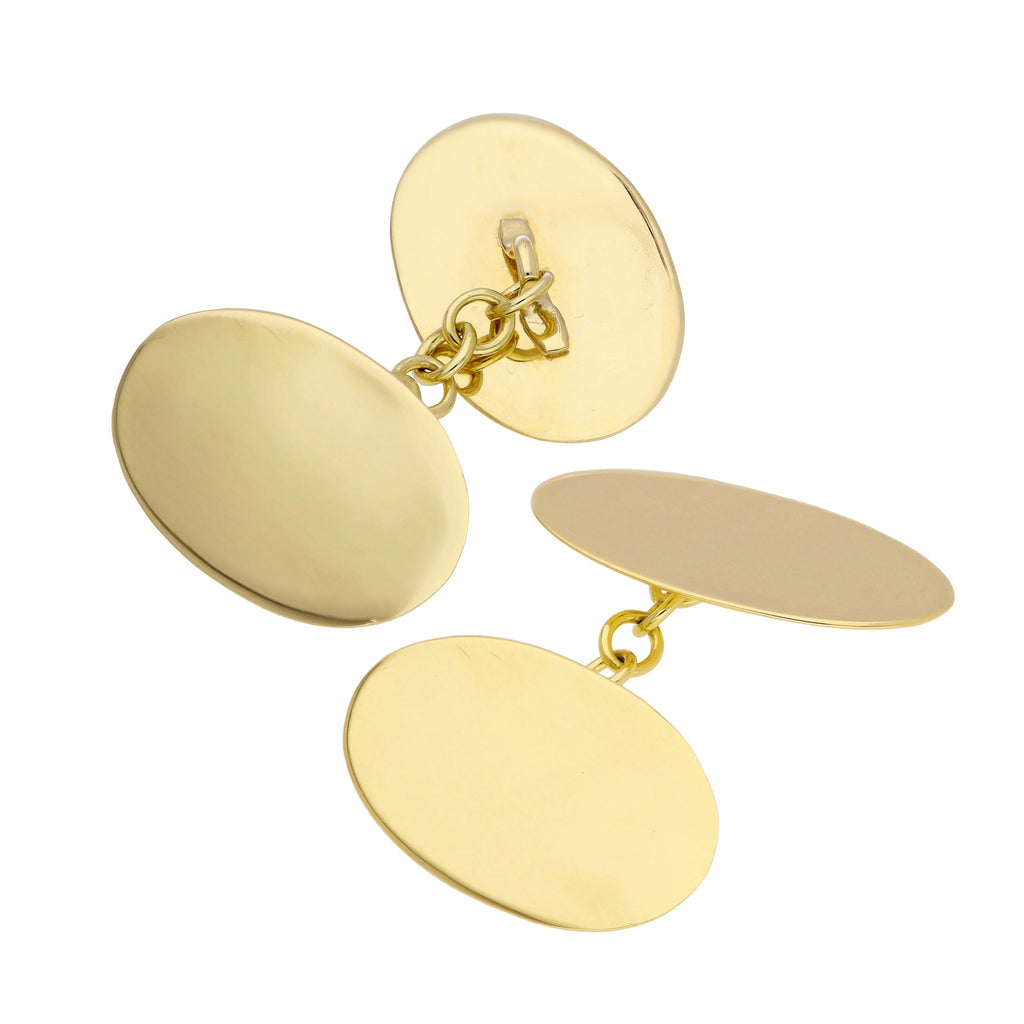
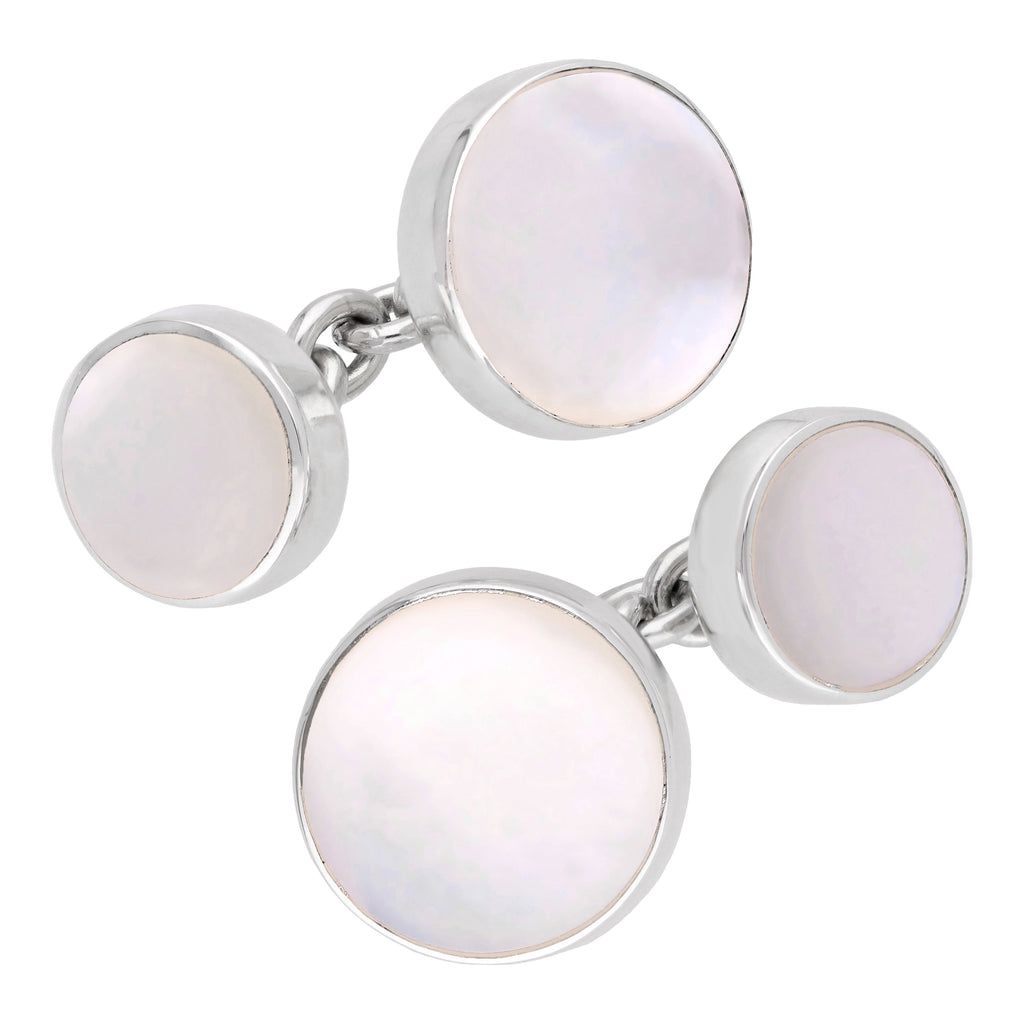
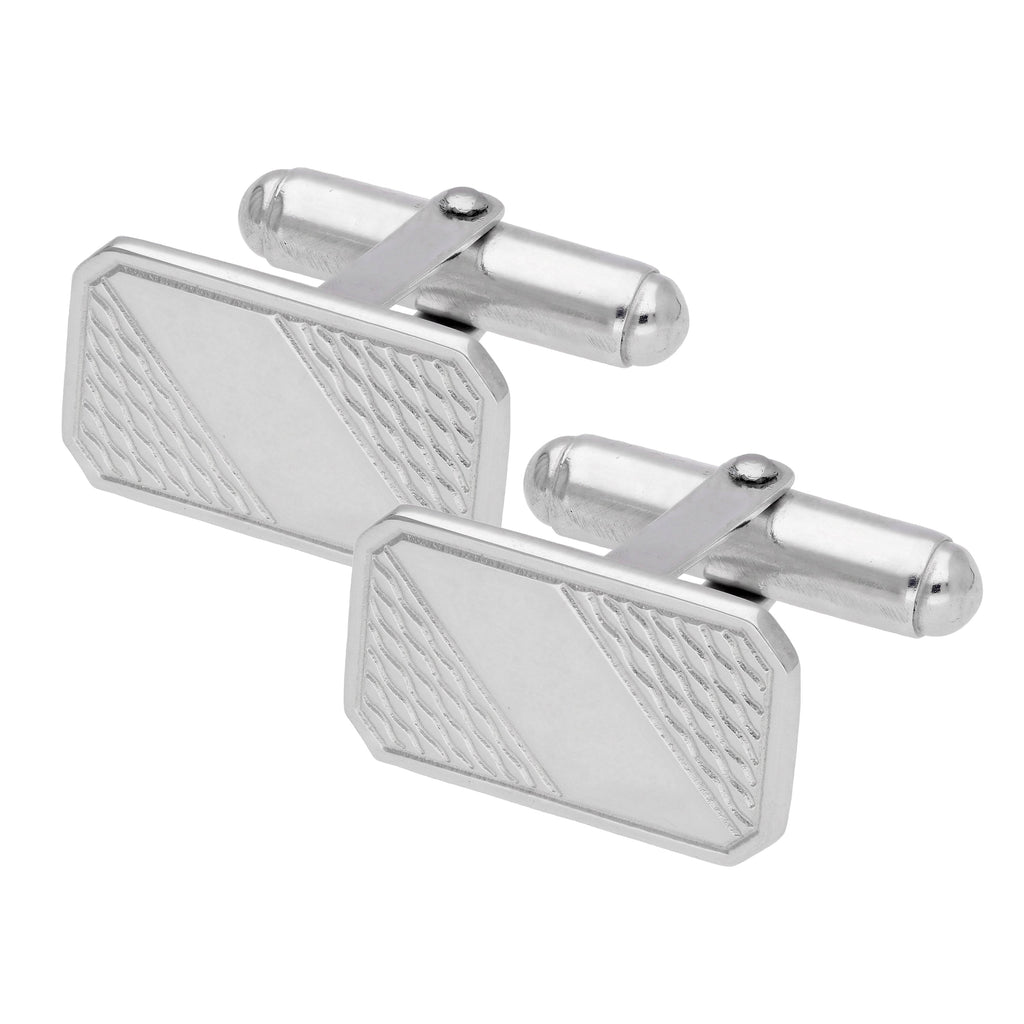
Sterling Silver is the foundation of British craftsmanship. Bright, cool-toned, and enduring, it reflects light cleanly without ostentation. Over years of wear, it develops a subtle patina that speaks of use, not neglect. Sterling silver cufflinks are versatile enough for daily wear and formal events alike, bridging office and evening effortlessly. They remain the most traditional and timeless choice in men’s accessories.
Sterling silver is the London standard — dignified, dependable, and unmistakably British.
9ct Gold brings warmth and heritage. Its deeper hue carries a sense of occasion, favoured for weddings, retirements, and milestone gifts. It holds engraving beautifully and rewards proper care with a lasting lustre. For those who appreciate quiet luxury, 9ct gold cufflinks are as much an heirloom as an accessory.
Enamel adds precision and personality. Fired at high temperatures over silver or gold, it creates rich, enduring colour that won’t fade or flake. Enamel cufflinks allow for subtle pattern, heraldic detailing, or a discreet accent of blue or black — a chance to express individuality without excess.
Mother of Pearl offers contrast and texture. Its natural iridescence softens metal edges and pairs beautifully with crisp white shirts. Traditionally associated with refinement and restraint, it remains a favourite for black-tie wear and gifts that carry understated sentiment.
The measure of craftsmanship lies in the detail — the polish of the edges, the depth of the engraving, the precision of the hinge. These are not accessories made quickly, but slowly, with care.
Each pair of cufflinks is inspected and polished by hand in our London workshop. The result is a piece that feels considered, looks enduring, and holds its place in a lifetime of well-chosen gifts.
Engraving and Personalisation Tips
Engraving transforms a fine gift into something singular. It adds character without changing the form and makes a piece unmistakably personal. Whether chosen to celebrate a wedding morning, a retirement, or a long partnership, the engraving should feel thoughtful, not decorative for its own sake.
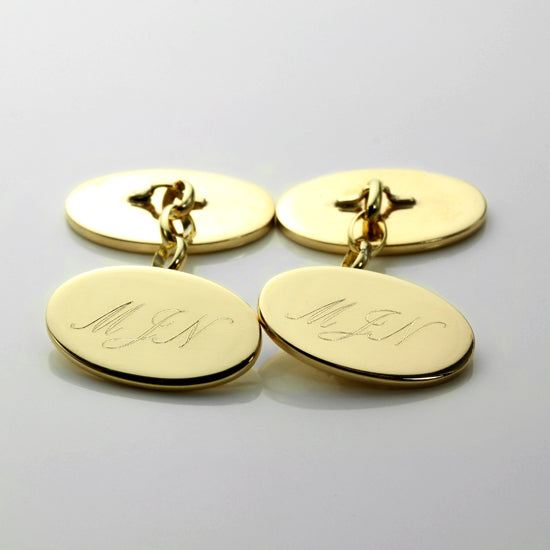


Keep it brief. The best engravings are simple: initials, a date, or a few words that carry meaning. Too much text crowds the metal and dilutes the sentiment. A short line such as To J.M., 2025 or Always With You says more than a phrase that has to be read twice.
An engraving should feel discovered, not announced. It’s there for the wearer — a private message on a public piece.
Choose the right font. Classic serif or block scripts age best. Modern fonts can look sharp at first but may feel out of step as styles shift. Script fonts suit romantic messages, while clean sans-serif lettering works well for corporate or commemorative gifts.

Consider placement. Some cufflinks can be engraved on the reverse or the swivel bar. The back keeps the message discreet; the bar is more visible when fastening the cuff. For family crests or monograms, the face itself can be engraved, though this suits heavier metals such as 9ct gold or sterling silver more than enamel or mother of pearl.
Placement and proportion matter as much as the words. A perfectly centred, finely cut engraving reflects care in every stage of the gift.
Match tone to occasion. A retirement gift might bear initials and years of service. Wedding cufflinks could carry a date or the couple’s initials entwined. Corporate gifts benefit from precision — a logo, a name, or a subtle emblem. Whatever the message, it should feel personal but professional, never promotional.
At Sayers London, each engraving is carried out by precision laser in our London workshop. The depth, angle, and finish are adjusted to suit the metal, ensuring that the inscription will remain legible long after the event it marks. The aim is permanence — a message that outlasts the moment and becomes part of the piece itself.
Maintenance & Storage
Fine cufflinks deserve the same care as any piece of jewellery. They may be small, but the materials — sterling silver, 9ct gold, enamel, and mother of pearl — all require proper handling to preserve their finish and function. A few consistent habits will ensure they age gracefully and remain ready for every occasion that calls for them.
After wearing, give your cufflinks a quick wipe with a soft, lint-free cloth to remove fingerprints, moisture, or traces of cologne. Even the cleanest hands leave a light film that can dull polished metal over time. Silver in particular benefits from regular light polishing; it prevents tarnish from taking hold rather than trying to remove it later.
The simplest routine — a cloth, a box, and a moment’s care — is enough to keep silver bright and gold warm.
Avoid chemical exposure. Perfume, hairspray, and cleaning agents can all affect the surface of silver, gold, and enamel. Put cufflinks on last when dressing and remove them before washing hands or applying scent. If they are exposed to water or soap, dry them fully before storing.
Storage matters. Keep each pair in a soft-lined box or individual pouch to prevent scratches. Silver benefits from a tarnish-resistant cloth or anti-tarnish strip in the case. Store in a cool, dry place away from direct sunlight and humidity. For collectors, a small drawer organiser or presentation case helps ensure each pair is visible but protected.
Treat them as you would a fine watch: out of sight of the elements, within easy reach when the occasion calls.
Professional cleaning should only be needed occasionally, but when it is, choose a jeweller familiar with precious metals. Avoid ultrasonic cleaners for enamel or mother of pearl pieces; they can loosen or damage the inlays. A gentle hand polish by a specialist will restore lustre without removing the subtle signs of age that give silver and gold their character.
With careful use and proper storage, well-made cufflinks will not simply last decades — they will improve with them. The slight softening of edges, the gentle oxididation of silver, and the weight of history in each engraving are what make them worth passing on.
Best Occasions: Weddings, Black Tie, Corporate Events
Cufflinks belong to life’s defining moments — the days that call for attention to detail and the quiet confidence that comes from being properly dressed. They are not everyday necessities, but deliberate choices that elevate an outfit when the occasion deserves it.
Weddings remain the natural home of cufflinks. For the groom, best man, and close family, they are both attire and memento. Sterling silver pairs engraved with initials or a wedding date strike the perfect balance between tradition and sentiment. For black tie receptions, polished onyx or mother of pearl adds depth and contrast against a white cuff. For the bridal party, matching designs in subtle variations can unify the look without feeling uniform.
The best wedding cufflinks are timeless — chosen once, worn for a lifetime, and remembered long after the photographs fade.
Black tie events demand restraint and precision. A double cuff shirt, a well-cut dinner jacket, and discreet cufflinks form the essential trio. Silver or gold with a plain or enamel face keeps the look clean and confident. Avoid novelty or coloured designs; black tie is about form, not flair. A pair of classic chain link cufflinks polished to mirror brightness signals respect for the formality of the evening.
Corporate occasions — award dinners, board meetings, or presentations — call for refinement without show. Sterling silver cufflinks engraved with initials, a logo, or a date of service make thoughtful corporate gifts that align appreciation with craftsmanship. They also sit perfectly within a professional wardrobe, adding subtle definition to a suit without overt luxury.
When the dress code reads formal, cufflinks are not an accessory — they are the finishing line between well-dressed and complete.
From weddings to the boardroom, cufflinks serve as a marker of respect: for the event, the people involved, and the tradition of dressing with care. In every context, they do what fine details should — they refine, they balance, and they remind us that presentation is a form of courtesy.

